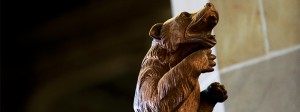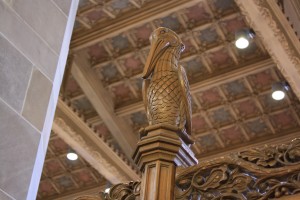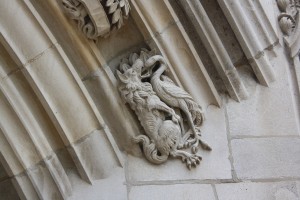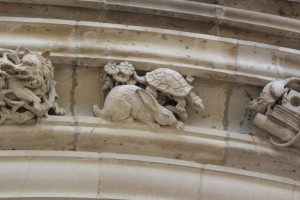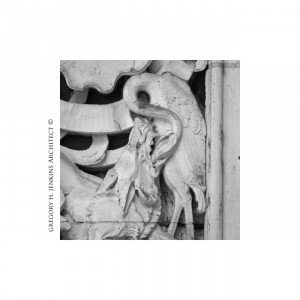Carvings of creatures from Aesop’s fables by American sculptor Rene Paul Chambellan adorn two of the Chicago area’s great Gothic Revival buildings: The Chicago Tribune Tower on Michigan Avenue (1925) and Deering Library on Northwestern’s Evanston campus (1932).
Aesop is a legendary ancient Greek figure thought to have lived in the 6th century B.C. He was a slave who acquired his freedom by an act of cunning and to whom ancient sources attribute scores of tales of virtue and vice, as well as cleverness and stupidity, related by speaking animals. Collections of Aesop’s fables are so wildly known in translation that they have been called “global cultural property.”
Both of these notable gothic buildings mobilize the broad appeal of the fables. The wooden menagerie for the doorways and ledges of Northwestern’s beautiful Deering Library includes bears, birds and frogs.
The stone pairs of animals in the archways feature some of the best known fables: a wolf and crane, a tortoise and a hare.
Deering’s design included these details at the request of University Librarian Theodore W. Koch, who oversaw the library’s construction in the early 1930s and brought a sense of whimsy along with a devotion to literature, history and culture to the project. Chambellan’s carvings offset the imposing architecture, adding a sense of levity and humor without compromising the moral seriousness of the place. The library he envisioned would celebrate the intellectual tradition in all its dimensions. Aesop’s animals were a canny ornamental choice. Though best known as moralizing children’s fare, the deceptively simple fables have a long and complex history as vehicles of moral, philosophical and political discourse. Aesop’s fables usually take the point of view of the weaker character, and some voice subversive views. Even in antiquity, they weren’t known solely as children’s tales. They were much more edgy and critical, and certainly aimed at thinking adults.
For the Tribune Tower, sculptor Chambellan created “Aesop’s Screen” – a stone archway embellished with carvings of people and animals, including many depictions of Aesop’s fables. Details of the screen with links to the text of the relevant fables can be viewed here. What could invoking the fables at the entrance to the Tribune‘s imposing home on Michigan Avenue suggest? The high moral purpose of journalism as a public service? A challenge to the people associated with the Tribune to uphold personal standards in the conduct of their profession? The assertion that stories can be both significant and amusing? The possibility that Chicago stories could claim space on the global stage?
Both buildings indicate the reach of thoughts of classical antiquity as great cultural projects were envisioned for Chicago. In these cases we see classical antiquity haunting grand neo-Gothic Chicago spaces.
The Tribune Tower gestures to classical antiquity in another way as well. The exterior facade incorporates scores of small rocks from significant sites all over the world brought back by Tribune reporters, including the Parthenon on the Acropolis in Athens and the Roman Colosseum. The 1922 design competition for the Tribune Tower also included a nod to classical antiquity. One entry proposed a building shaped like a single rising Doric column. It wasn’t a serious submission but rather a pun on the journalist’s trade, the production of newspaper columns. ]
(R.L., A.G., S.S.M.)

